#national museum & gallery of wales
Text
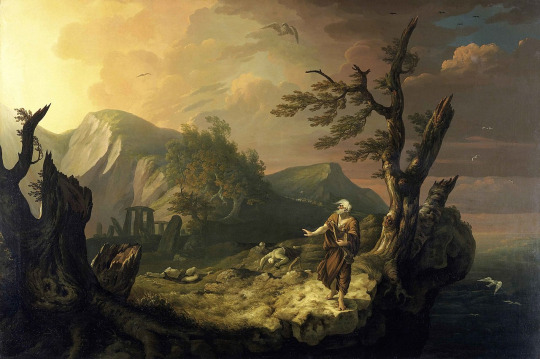
Thomas Jones (1742-1803)
"The Bard" (1774)
Oil on canvas
Romanticism
Located in the National Museum, Cardiff, Wales
Poised on the edge of cliff clutching a harp, the last surviving bard places a curse on the English invaders before leaping to his death. This dramatic history painting has become iconic for Wales. Based on Thomas Gray’s poem "The Bard," it recounts the tale of Edward I’s massacre of the Welsh bards.
Bards were highly regarded in Welsh society at that time, and were thought to be descendants of the Celtic druids. Jones makes this connection by giving his Bard druidic features – a long white beard and hooded robe. The stone circle in the background, based on Stonehenge, emphasizes the antiquity of the druid.
#paintings#art#artwork#history painting#welsh culture#thomas jones#oil on canvas#fine art#romanticism#romantic movement#welsh artist#history#welsh history#landscape#national museum of wales#museum#art gallery#death#violence#1770s#late 1700s#late 1800s
101 notes
·
View notes
Text
STATE VISIT BY THE EMPEROR AND EMPRESS OF JAPAN
Tuesday 25th - Thursday 27th June 2024
Their Majesties The Emperor and Empress of Japan will pay a State Visit to the United Kingdom as guests of His Majesty The King from Tuesday 25th to Thursday 27th June 2024.
Their Majesties The King and Queen will host the State Visit at Buckingham Palace.
STATE VISIT PROGRAMME:
SATURDAY 22nd JUNE
• The Emperor and Empress of Japan will arrive privately in the United Kingdom on the afternoon of Saturday 22nd June at Stansted Airport.
• Their Majesties will be greeted by His Excellency Mr Hajime Hayashi, Ambassador of Japan. The Viscount Brookeborough KG, Lord-in-Waiting, will greet Their Majesties on behalf of The King.
SUNDAY 23rd JUNE AND MONDAY 24TH JUNE
• Before the State Visit formally commences, the Emperor will conduct a private programme of engagements, including a visit to Japan House and the Thames Barrier.
TUESDAY 25th JUNE
• His Royal Highness The Prince of Wales will greet the Emperor and Empress of Japan, at their hotel, on behalf of The King on Tuesday morning.
• His Royal Highness will travel with the Emperor and Empress to Horse Guards Parade, where Their Majesties will receive a Ceremonial Welcome.
• The King and Queen will formally welcome the Emperor and Empress at the Royal Pavilion on Horse Guards Parade. Presentations will be made, the Guard of Honour will give a Royal Salute and the Japanese National Anthem will be played.
• The King and Queen will formally welcome the Emperor and Empress at the Royal Pavilion on Horse Guards Parade. Presentations will be made, the Guard of Honour will give a Royal Salute and the Japanese National Anthem will be played.
• The Emperor, accompanied by The King, will then inspect the Guard of Honour, formed of the 1st Battalion Welsh Guards with the Band of the Welsh Guards. Afterwards, the Emperor and Empress will join The King and Queen, and The Prince of Wales, in a carriage procession along The Mall to Buckingham Palace, where they will be met by a second Guard of Honour formed of the 1st Battalion Welsh Guards.
• Following a lunch at Buckingham Palace, given by The King, His Majesty will invite the Emperor and Empress to view a special exhibition in the Picture Gallery of items from the Royal Collection relating to Japan.
• In the afternoon, the Emperor and Empress will visit Westminster Abbey, where the Emperor will lay a wreath at the Grave of the Unknown Warrior. Their Majesties will take a tour of the Abbey, accompanied by the Dean of Westminster.
• In the evening, The King, accompanied by The Queen and Members of the Royal Family, will give a State Banquet at Buckingham Palace for The Emperor and Empress of Japan. Speeches will be made by The King and the Emperor at the beginning of the banquet.
WEDNESDAY 26th JUNE
• The Emperor will visit The Francis Crick Institute, the UK's flagship biomedical research centre. The Institute supports an innovative UK-Japan research partnership which covers a range of public health issues, including cancer, vaccines, and the role of genetics in infectious diseases.
• That evening, The Emperor of Japan, joined by Their Royal Highnesses The Duke and Duchess of Edinburgh, will attend a Banquet at the Guildhall given by the Lord Mayor and City of London Corporation. The Lord Mayor and The Emperor will both make speeches at the end of the banquet.
THURSDAY 27th JUNE
• The Emperor and Empress of Japan will formally bid farewell to The King and Queen at Buckingham Palace on the morning of the final day of the official State Visit programme.
• The Emperor and Empress will travel to Young V&A, part of the V&A family of museums dedicated to the power of creativity around the world, where the museum's Japan: Myths to Manga exhibition is currently on display.
• The Emperor will privately visit St. George's Chapel, Windsor Castle, to lay a wreath on the tomb of Queen Elizabeth II, in the King George VI Chapel. The Garter Banners of the current members of the Order of the Garter, including the banner belonging to • His Majesty's father, Emperor Emeritus Akihito, are displayed in the Quire of St. George's Chapel.
• Later that afternoon, His Majesty the Emperor will tour the historic Temperate House at the Royal Botanic Gardens, Kew. The Millennium Seed Bank, coordinated by Kew is the world's largest collection of over 2.4 billion wild plant seeds spanning 97 countries, preserving Japanese and international biodiversity. Bronze Bonsai sculptures by artist Marc Quinn are currently displayed in the Temperate House, surrounded by a display of Bonsai trees from Kew's collection.
FRIDAY 28th JUNE
• On their final day in the UK, The Emperor and Empress of Japan will visit Oxford for a private programme of engagements including a visit to the colleges where Their Majesties studied.
• At the conclusion of the visit, The Lord Chamberlain will bid farewell to the Emperor and Empress on behalf of The King, before they depart from RAF Brize Norton.
110 notes
·
View notes
Text

Jan Nelson, Walking in tall grass, Shelby 2, 2011, oil on linen, 79 h cm, 56 w cm, National Gallery of Australia, Kamberri/Canberra, warwick and Jane Flecknoe Bequest Fund 2015 © Jan Nelson/Copyright Agency
Jan Nelson (born 1955) is an Australian artist who works in sculpture, photography and painting. She is best known for her hyper real images of adolescents. She has exhibited widely in Australia as well as Paris and Brazil. Her works are in the collections of Australian galleries, including the National Gallery of Australia, National Gallery of Victoria, Art Gallery of New South Wales, Museum of Contemporary Art, Sydney and the Gallery of Modern Art Brisbane, as well as major regional galleries. She represented Australia in the XXV biennale in São Paulo, Brazil.
22 notes
·
View notes
Text

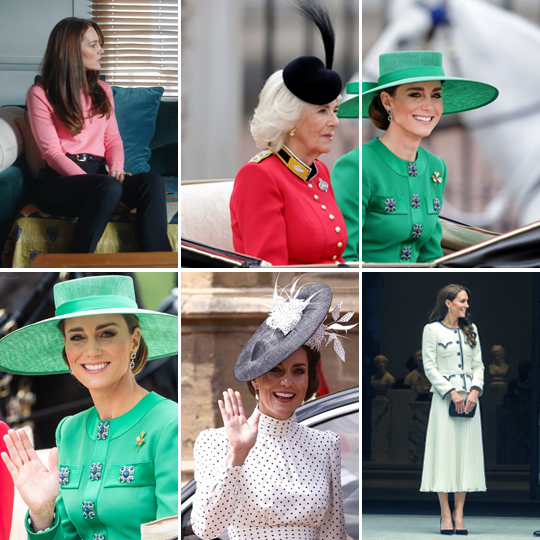

The Princess of Wales’ Year in Review: June
June 1st - The Prince and Princess of Wales were present at the Marriage of The Crown Prince of the Hashemite Kingdom of Jordan with Miss Rajwa Al Saif which took place at the Zahran Palace. They then attended the wedding reception
June 6th - The Princess of Wales visited Windsor Family Hub. That afternoon, she received Mrs. Alice Webb (Trustee of The Royal Foundation) at Windsor Castle
June 7th - The Princess of Wales, Joint Patron of the Royal Foundation and Patron of the Rugby Football Union, visited Maidenhead Rugby Football Club
June 8th - The Princess of Wales, Joint Patron of the Royal Foundation, held an Early Years Meeting
June 14th - The Princess of Wales, Joint Patron of the Royal Foundation, held an Early Years Meeting
June 15th - The Princess of Wales, Joint Patron of the Royal Foundation of The Prince and Princess of Wales, visited Riversley Park Children's Centre. Later, she received Professor Eamon McCrory (Board Member of the Royal Foundation Centre for Early Childhood Advisory Group) at Windsor Castle
June 16th - A film was released highlighting the vital role that health visitors play in the community, which includes footage of The Princess of Wales shadowing health visiting teams at Homerton Healthcare NHS Foundation Trust. That evening, the Prince of Wales, Colonel of the Welsh Guards, and The Princess of Wales, Colonel of the Irish Guards, attended the Senior Colonels' Conference and Dinner at Clarence House
June 17th - The Wales family joined the extended members of the British Royal Family at The King's Birthday Parade, also known as Trooping the Colour
June 19th - The Princess of Wales was present when the King, accompanied by The Queen, The Prince of Wales, and others, held a Chapter of the Most Noble Order of the Garter in the Throne Room, Windsor Castle. The King later gave a Luncheon Party for the Companions of the Most Noble Order of the Garter at which The Queen, The Prince and Princess of Wales, and others were present
June 20th - The Princess of Wales, Patron of the National Portrait Gallery, officially reopened the newly renovated National Portrait Gallery
June 22nd - Prince George was spotted touring Eton alongside his parents
June 23rd - The Prince and Princess of Wales honoured Royal Ascot with their presence
June 24th - The Princess of Wales joined Roger Federer in a video for Wimbledon, focusing on the ball boys and girls
June 27th - The Princess of Wales officially opened Hope Street
June 28th - The Princess of Wales, Patron of the Victoria and Albert Museum, officially reopened the newly renovated Young Victoria and Albert Museum
June 29th - The Princess of Wales, Joint Patron of the Royal Foundation, held an Early Years Meeting. Afterwards, she held further meetings. The Country Life cover photographed by the then-Duchess of Cambridge won the Cover of the Year title at the PPA Awards, the ‘Oscars’ of the magazine world
June 30th - The Princess of Wales, Joint Patron of the Royal Foundation, received Professor Eamon McCrory (Board Member of the Royal Foundation Centre for Early Childhood Advisory Group) at Windsor Castle
#mine#royaltyedit#kate#yearreview#hussein and rajwa#windsor family hub 23#alice webb 23 2#maidenhead23#ey meeting 23 9#ey meeting 23 10#nuneaton23#eamon mccrory 23 3#colonel conference 23#trooping the colour 2023#garter 23#npg23#ascot23#ball boys and girls 23#hope street#vanda23#ey meeting 23 11#meeting23 2#eamon mccrory 23 4
44 notes
·
View notes
Text

Prince George of Wales, a Protestant royal and heir to the English throne (and later King George IV), found himself enchanted with Maria Anne Fitzherbert, a twice-widowed devout Catholic, six years his senior. George sent to his beloved a tiny treasure, called an "eye jewel". Its origins are rooted in miniature painting and they were a Georgian fashion rage.
Below: Joshua Reynolds • Portrait of King George IV
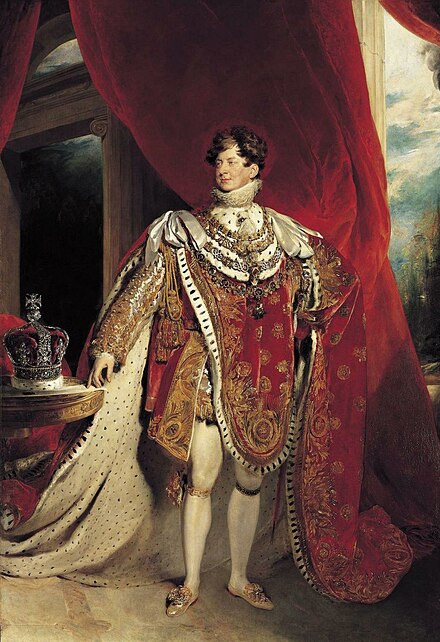
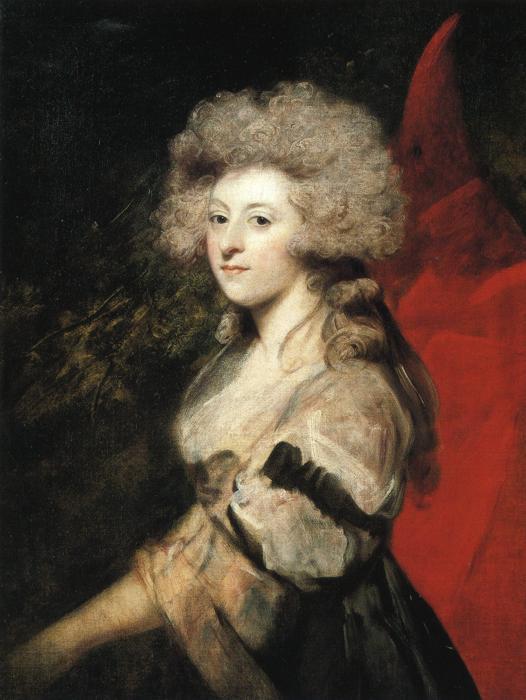
Sir Joshua Reynolds (British/English) • Maria Anne Fitzherbert • 1788 • National Portrait Gallery
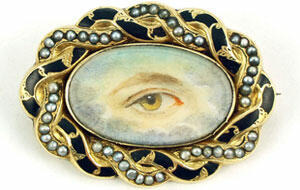
They were once tokens of romantic love. They were also mourning pieces; the eye of the deceased represented within a tiny, ornate frame. In this case, the pearls around the frame represent tears and the clouds, the passage to heaven.
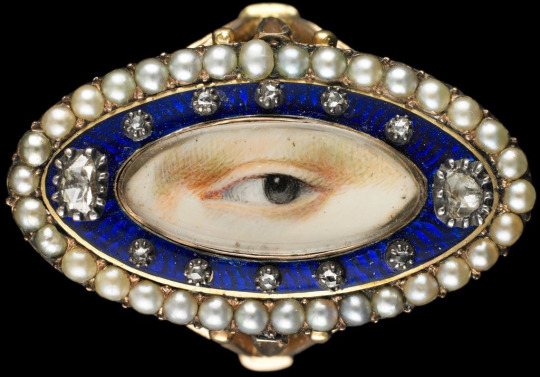
Unknown maker • Here is an eye jewel fashioned as a ring.
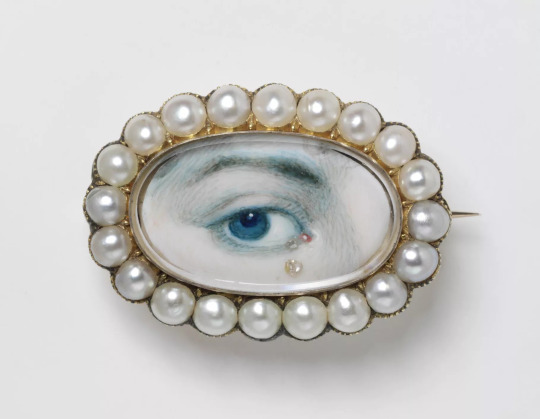
Unknown maker • Miniature (brooch) • early 19th century • © Victoria and Albert Museum, London.

Philadelphia Museum of Art, Philadelphia, Pennsylvania
#art#painting#art history#miniature painting#eye jewels#georgian fashion#georgian era#history of fashion#georgian jewelry#fashion history#royal portraits#the resplendent outfit#joshua reynolds
35 notes
·
View notes
Text
2024 Garden Parties!!!
The dates for The King's Garden Parties* in 2024 are as follows:
✨ Buckingham Palace - Wednesday 8th May 2024

The King and Queen, the Duke and Duchess of Edinburgh and the Duke and Duchess of Gloucester hosted the first garden party of 2023
✨ Buckingham Palace - Tuesday 21st May 2024
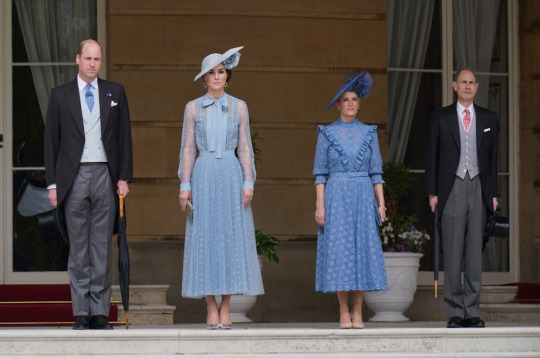
Last year (2023) the Prince and Princess of Wales with the Duke and Duchess of Edinburgh hosted the Kings Garden Party at Buckingham Palace
✨ Palace of Holyroodhouse - Tuesday 2nd July 2024
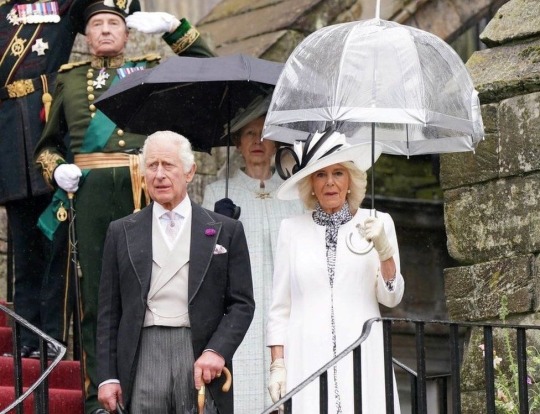
The King and Queen with the Princess Royal hosted last years Holyrood week garden party
*Please note, Garden Parties are traditionally referred to as The Sovereign's Garden Party. Attendance at each Garden Party will be confirmed on the day.
✨ The Creative Industries Garden Party - Wednesday 15th May 2024
His Majesty The King has given permission for a Garden Party to be hosted at Buckingham Palace, with support from the Department for Culture, Media and Sport, in celebration of the Creative Industries of the United Kingdom. The Garden Party will bring together approximately 4,000 representatives across culture, art, heritage, film, TV, radio and fashion.
The Garden Party will celebrate the economic value of the sector to the UK economy in helping to showcase British culture and creativity around the Globe. In 2022 the Creative Industries generated over £124 billion in economic value and employed 2.4 million people in the United Kingdom. From theatre to video games, publishing to design, museums and galleries to film sets and music studios, the creative industries, and the creators and organisations within them, bring happiness, prosperity and help shape the world around us.
✨ The Not Forgotten Association Annual Garden Party - Friday 17 May 2024
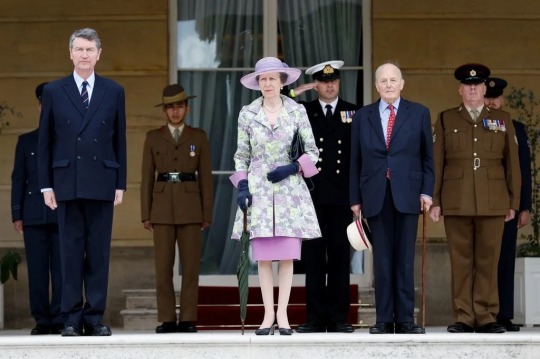
From the Not Forgotten Association garden party in 2022
His Majesty The King has given permission for The Not Forgotten Association Annual Garden Party to be held by The Princess Royal, accompanied by Vice Admiral Sir Tim Laurence, in the Buckingham Palace Garden on Friday, 17th May 2024.
The Not Forgotten Association is a tri-service charity which provides entertainment, leisure and recreation for ex-service men and women with disabilities or illness and serving personnel who are wounded, injured or sick. The Garden Party will bring together 2,000 beneficiaries of all ages and from all services.
The Princess Royal is Patron of The Not Forgotten Association.
✨ Royal National Lifeboat Institution (RNLI) - Thursday 23rd May 2024


The Duke of Kent and Sir Tim Laurence attending the RNLI 200 service of thanksgiving at Westminster Abbey in March 2024
His Majesty The King has also given permission for the RNLI 200 Anniversary Garden Party to be held by The Princess Royal, accompanied by Vice Admiral Sir Tim Laurence, and The Duke of Kent in the Buckingham Palace Garden on Thursday, 23rd May 2024 in celebration of the charity's milestone anniversary.
Since the RNLI was founded on 4th March 1824, following an appeal to the nation from Sir William Hillary, the charity has saved 146,277 lives - this equates to an average of two lives saved every day for 200 years. Today, the RNLI operates 238 lifeboat stations around the UK and Ireland, including four on the River Thames, and has seasonal lifeguards on around 240 beaches around the UK.
The Duke of Kent has been President of the RNLI since 25th March 1969. In his 55 years as President, the RNLI's volunteer lifeboat crews and beach lifeguards have saved more than 51,000 lives. Sir Tim Laurence is also Vice President of the charity.
The Garden Party will bring together 2,500 of the charity's long-serving volunteers, staff and their families as well as featuring an Atlantic 85 inshore lifeboat.
#exciting!!!#garden parties mean SUMMER!!!!!#these will be so much fun to follow#princess anne#princess royal#tim laurence#timothy laurence#king charles iii#prince edward duke of kent
19 notes
·
View notes
Text
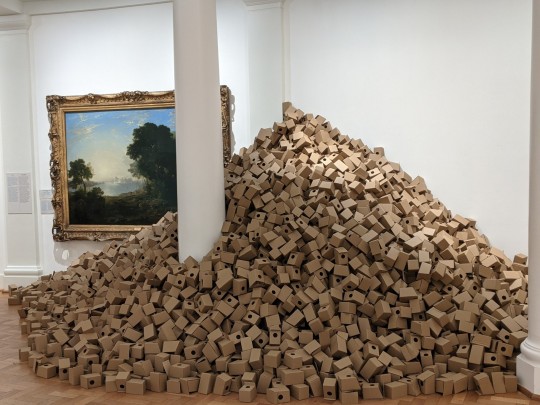
This is a piece of artwork called Unlliw, created in 2002 by Welsh artist Carwyn Evans in response to a proposal to build 6,500 new homes in Ceredigion.

It's a brilliant piece intended to provoke discussion of the cultural and environmental impact of this sort of new build housing in less densely populated areas. However, as an archaeology graduate, the thing that really strikes me about this exhibition is that it's a true masterstroke of curation - the way in which the work is exhibited in the gallery enhances the intent of the original work in a way that the artist had not envisioned.
You see, this is the landscapes gallery of the National Museum of Wales, in Cardiff. It's a huge, curved gallery that takes you on a journey throughout art history, with sumptuous landscapes by classical masters depicting the beauty of the Welsh landscape on each great curved wall, and sculptures dotted throughout the middle of the gallery. Towards the end of the gallery, you round the corner and you see this mass of cardboard, piled up against the wall, obscuring a beautiful oil painting. It's shocking. It's out of place. It's actually literally covering part of that painting, there is a part of the landscape that you just can't see any more because of these 6,500 cardboard bird houses.
It's a phenomenal use of a piece of artwork to demonstrate the original intent of the artist, to provoke the feelings that Evans wanted to provoke, and to make you think about art and curation and space in a new way.
Quite frankly it's the best single piece of curation I've ever seen.
If you want to read the full statement of work Carwyn Evans made in 2002 it's here.
#wales#welsh language#politics#uk#art#philosophy of art#museum#aesthetics#curation#art history#art academia#urban planning
177 notes
·
View notes
Text
Princess of Wales Photo Challenge: Day 27
Favourite photo of Catherine with her patronages




Catherine has got patronages in 4 main areas:
The early years, children and families
Sport
Mental Health
Museums and Art
I decided that all 4 deserved to be represented and I like these photos the most as a representation of her work.
The 1st photo was taken at EACH (East Anglia Children’s Hospice) in Milton on 23rd June 2022. The 2nd on 18th October 2013 for Sports Aid while the 3rd was taken at the London Marathon on 23rd April 2017 for Heads Together. The last photo was taken at the National Portrait Gallery for its reopening on 20th June 2023.
9 notes
·
View notes
Text
OFMD Stede Bonnet as a Macaroni: Wealth, Gender and Sexuality in the 18th Century Fashion World
Historical Inaccuracy in Our Flag Means Death? Never!
Historical inaccuracy! I hear you cry. A Macaroni in 1717!?! It is true macaroni fashion was really a late-18th century fashion trend, seemingly reaching its peak in the 1770s. However Our Flag Means Death is nothing if not historically inaccurate. Stede’s costumes seem to take inspiration from across the 18th century rather than worrying about what would have actually been worn in 1717.
Early 18th century suits tended to have round necklines, loose-fitting sleeves with wide cuffs, long waistcoats that stoped just above the knee, and coats with full skirts just a little longer that the waistcoat.

[Left: Matthew Prior, oil on canvas, c. 1713-1714, by Alexis-Simon Belle, photo credit: St John's College, University of Cambridge, via Art UK.
Middle: Matthew Hutton of Newnham, Hertfordshire, oil on canvas, c. 1715, by Johannes Verelst, photo credit: National Trust Images, via Art UK.
Right: William Leathes, Ambassador Brussels, oil on canvas, c. 1710-1711, by Herman van der Myn, photo credit: Colchester and Ipswich Museums Service: Ipswich Borough Council Collection, via Art UK.]
As the century continued we get standing collars and turned down collars but round necklines were still around as well, sleeves got tighter with smaller cuffs, the waistcoats got shorter and the coats lost their skirts.
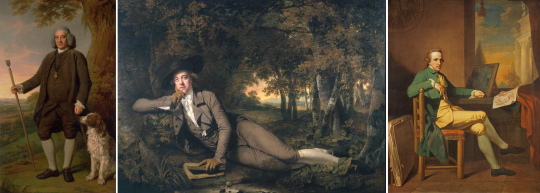
[Left: Thomas ‘Sense’ Browne, oil on canvas, c. 1775, by Nathaniel Dance-Holland, photo credit: Yale Center for British Art, via Art UK.
Middle: Sir Brooke Boothby, oil on canvas, c. 1781, by Joseph Wright of Derby, photo credit: Tate, via Art UK.
Right: David Allan, oil on canvas, c. 1770, by David Allan, photo credit: Royal Scottish Academy/National Galleries of Scotland (Antonia Reeve), via Art UK.]
Stede’s collars are inconstant some are rounded but others are turned down and Ed’s purple suit has a standing collar. Many of Stede’s coats have wide cuffs, but most have little skirt to them. His teal suit from the pilot has a bit of a skirt but its paired with a short waistcoat.

Most of Stede’s waistcoats are short with the exception of his suits from both the wedding portrait with Mary and the the family portrait. Both suits are very straight giving him a boxy appearance and are pretty different from most of the suits we see him in.

All in all I don’t think they were aiming for historically realistic clothes but with the collars, short waistcoats, and lack of skirts I get more of a late-18th century vibe.
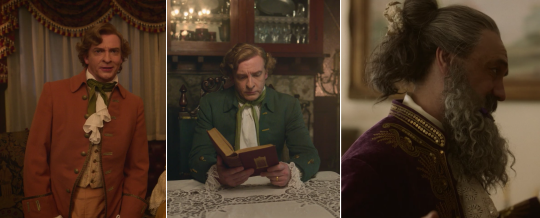
So what was a Macaroni?
A Classical Dictionary of the Vulgar Tongue (1785), defined macaroni as follows:
An Italian paste made of flour and eggs; also a fop, which name arose from a club, called the maccaroni club, instituted by some of the most; dressy travelled gentlemen about town, who led the fashions, whence a man foppishly dressed, was supposed a member of that club, and by contraction stiled a maccaroni.
The macaroni club was said to have comprised of young men who had gained a taste for French and Italian textiles on their Grand Tour (a traditional trip taken tough Europe by upper class men when they came of age). The earliest reference to the club is from a letter from Horace Walpole to Lord Hertford on the 6th Feb 1764:
at the Maccaroni Club (which is composed of all the travelled young men who wear long curls and spying-glasses),
In his book Pretty Gentleman: Macaroni Men and the Eighteenth-Century Fashion World Peter McNeil suggest the club was actually Almack’s. Almack’s was a private club at 50 Pall Mall that was attended by prominent Whigs including Sheridan, Fox and the Price of Wales. (p52) While the name may have originated from the men at Almack’s it was soon used to describe any man who followed the associated fashion trends.
So what were these trends?
Hair
“Still lower let us fall for once, and pop
Our heads into a modern Barber’s shop;
What the result? or what we behold there?
A set of Macaronies weaving hair.”
~ The Macaroni by Robert Hitchcock
Probably the most iconic aspect of macaroni fashion was the hair. “It was the macaroni attention to wigs that caused most consternation” explains Peter McNeil. The macaroni hair “matched the towering heights of the female coiffure, with a tall toupee cresting at the centre front. The wig generally had a long tail at the neck (’queue’), which when folded double was called the ‘cadogan’, all of which required regular dressing with pomade and powder, sometimes in the colours of pink, green or red.” (p45)
The height of the macaroni hair was a point of particular fascination in macaroni caricature exaggerating it beyond what the macaroni were probably actually wearing. Compare below Tom’s hair in the satirical print What is this my son Tom to the self portrait of Richard Cosway, who was satirised by Mary Darly as “The Miniature Macaroni” (a reference both to his height and his career as a miniature painter).
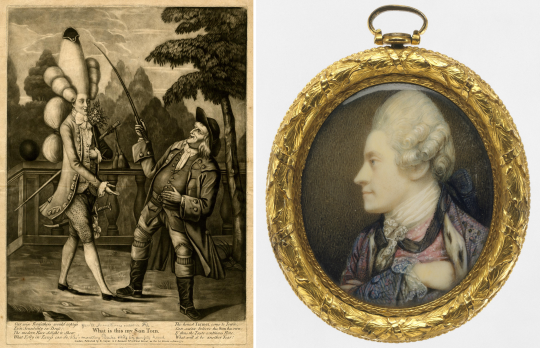
[Left: What is this my son Tom, print, c. 1774, published by Sayer & Bennett, via The British Museum.
Right: Self-Portrait, Ivory, c. 1770–75, by Richard Cosway, via The Met.]
The way Stede usually wears is hair is not particularly macaroni nor particularly 18th century for that matter. The exception to this is his wig from The Best Revenge Is Dressing Well though even this doesn’t have the iconic macaroni hight.

Interestingly both Stede and Ed are wearing flowers in their hair. While there are certainly depictions of women with flowers in there hair I’m not aware of this being a trend in mens fashion at all. However macaroni were known for wearing large nosegays.
While the tall hair was certainly iconic not all macaroni wore their hair tall. Joseph Banks, who was satirised as “The Fly Catching Macaroni” by Matthew Darly, is depicted in his portrait with a fairly typical 18th century hairstyle. Its not the hair alone that makes a macaroni, it was just one aspect of the fashion.
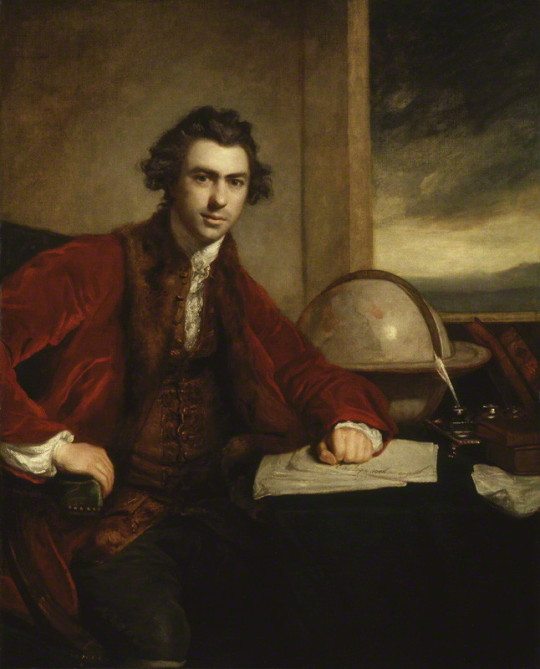
[Sir Joseph Banks, oil on canvas, c. 1771-1773, by Sir Joshua Reynolds, via Wikimedia.]
Suit
“If I went to Almack’s and decked out my wrinkles in pink and green like Lord Harrington, I might still be in vogue.” ~ Horace Walpole to Lord Hertford, 25 Nov 1764
Menswear of the period consisted of the same basic elements; shirt, stockings, breeches, waistcoat and coat. What differentiated the macaroni from others was the fabric, cut, colour and trimmings of the suit. “At a time when English dress generally consisted of more sober cuts and the use of monochrome broadcloth,” explains Peter McNeil “macaronism emphasised the effects associated with French, Spanish and Italian textiles and trimmings”. Popular amongst macaroni were brocaded and embroidered silks and velvets, sometimes further embellished with metallic sequins, simulated gemstones and raised metallic threads. Popular colours included pastels, pea-green, pink, red and deep orange. (McNeil, p30-32)
Far from wearing “monochrome broadcloth” Stede likes a “fine fabric” and dresses in a range of colours, we see him in teal, pink, purple, green, white, red, peach &c.
Tightly cut French style suits known as habit à la française were popular with macaroni. (McNeil, p14) Stede’s suits vary somewhat in cut but some are very French. The peach suit Stede wears in We Gull Way Back particularly has a very macaroni feel to me. Compare it to the English suit (left) and the French suit (right).

From the back you can see the English suit has more of a skirt to it.

Both Stede’s suit and the French suit are somewhat plain but have been paired with a floral embroidered waistcoat, while the English suit has a matching plain black waistcoat.
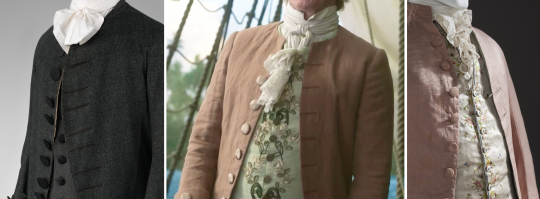
[Left: English suit, wool, silk, c. 1755–65, via The Met, number: 2009.300.916a, b.
Right: French suit, Silk plain weave (faille), c. 1785, via LACMA, number: M.2007.211.47a-b.]
Fabric covered button’s were common in the 18th century, you can see them on both the French and English coats above. In contrast Stede wears a lot of metal buttons. Steel buttons were popular amongst macaroni, a trend that was satirised in Steel Buttons/Coup de Bouton.

[Steel Buttons/Coup de Bouton, print, c. 1777, by William Humphrey, via The British Museum.]
Pumps and Parasols
“Maccaronies who trip in pumps and with Parasols over their heads” ~ Mrs Montagu
High heels had been popular amongst men during the 17th century. The Royal Collection Trust explains:
In the first half of the 17th century, high heeled shoes for men took the form of heeled riding or Cavalier boots as worn by Charles I. As the wearing of heels filtered into the lower ranks of society, the aristocracy responded by dramatically increasing the height of their shoes. High heels were impractical for undertaking manual labour or walking long distances, and therefore announced the privileged status of the wearer.
(Royal Collection Trust, High Heels Fit for a King)
In 17th century France Louis XIV popularised red-heels by turning them into a symbol of political privilege, which in turn spread the fashion to England. But with the sobering of menswear in England around the turn of the century the high heel and the red-heels went out of fashion. (see Bata Shoe Museum Toronto, Standing TALL: The Curious History of Men in Heels)
The high heel had a bit of a resurgence in the 1770s with macaroni fashion. The Natural History of a Macaroni snipes that the macaroni’s “natural hight is somewhat inferior to he ordinary size of men, through by the artificial hight of their heels, they in general reach that standard”. (Walker’s Hibernian Magazine, July 1777, p458)
Red-heels were reintroduced to England by young men returning from their Grand Tours. A young Charles James Fox (satirised by Mathew Darly as “the Original Macaroni”) wore such French style red-heeled shoes. The Monthly Magazine recalls a young Fox as a “celebrated “beau garçon” with “his chapeau bras, his red-heeled shoes, and his blue hair-powder.” (Oct 1806) and The Life of the Right Honorable, Charles James Fox recalls him in his “suit of Paris-cut velvet, most fancifully embroidered, and bedecked with a large bouquet; a head-dress cemented into every variety of shape; a little silk hat, curiously ornamented; and a pair of French shoes, with red-heels;” (p18) And in Recollections of the Life of the Late Right Honorable Charles James Fox B.C. Walpole recalls him as “one of the greatest beaus in England,” who “indulged in all the fashionable elegance of attire, and vied, in point of red heels and Paris-cut velvet with the most dashing young men of the age. Indeed there are many still living who recollect Beau Fox strutting up and down St. Jame’s-street, in a suit of French embroidery, a little silk hat, red-heeled shoes, and a bouquet nearly large enough for a may-pole.” (p24)
Compare the French style red-heeled shoes of Louis XIV to Stede’s red-heeled shoes.

[Left: detail of Louis XIV, oil on canvas, c. 1701, by Hyacinthe Rigaud, via Wikimedia.]
However most macaroni were depicted wearing the more standard late 18th century low-heeled bucked shoes. Where they distinguished themselves was the size and decoration of the buckles. “Such buckles could be set with pate (lead glass) or ‘Bristol stones’ (chips of quartz), or diamonds if you were very rich.” Explains peter McNeil, “The new macaroni fashion was for huge silver or plated Artois shoe buckles which the Mourning Post claimed weighed three to eleven ounces.” (p90)
While certainly not as iconic has his heels Stede also wears these sorts of shoes. Compare below the shoes from a macaroni caricature to Ed wearing Stede’s shoes (I couldn’t get a good shot of Stede wearing them).

[Left: detail of How d'ye like me, print, c. 1772, published by: Carington Bowles, via The British Museum.]
“A great many jewelled accessories accompanied the macaroni look”, writes Peter McNeil, “They included hanger swords, very long canes, clubs, spying glasses and snuff-boxes.” (p68) Tragically we don’t see Stede with a fashionable dress sword or a cane but we do see him with another accessory popular amongst macaroni; a parasol.
Popular in France parasols/umbrellas were adopted by the macaroni. They were popular amongst both men and woman in France but in England they had a feminine connotation. (McNeil, p129) In the 1780s as umbrellas became more popular amongst men there was a cultural pushback to the perceived gender transgression. On the 16th of August 1780 the Morning Post complains of of the “canopy of umbrellas” bemoaning that “the effeminacy of the men, inclines them to adopt this necessary appendage of female convenience”. On the the 4th Oct, 1784, the Morning Chronicle published a letter complaining of “that vile foppish practice of sheltering under a umbrella”. The author of this tirade writes that while “the ladies should be allowed to secure their beauty and persons from the heat of the sun, or the inclemency of the weather,” because “it is natural, and has a striking effect”, that “to see a great lubberly cit, bounce from his shop, with a coat, hat, and wig that are not together worth one groat,” sheltering “from the influence of the solar beam” was “intolerable.” However:
The macaroni being of the doubtful gender, may in part claim a feminine right; his dress is too delicate to bear an heavy shower, perhaps his person is so too; but a coach, if a clean one is to be found would serve his purpose much better, as there would be less likelihood of his being washed away into the kennel, which he deserves to be kicked into for his d-----d affectation.

Wealth
Born from rich young men returning from their tours with a taste for French and Italian textiles macaroni fashion was expensive. Certainly a working class man would not be able to afford Stede’s wardrobe. Both the sheer amount of clothes he has as well has the fabrics those clothes are made of are indications of wealth. However to say that Stede’s wardrobe is only an indication of wealth would be missing part of picture.
Most rich upper class English men (including colonial) wore plain monochrome suits. Even amongst the gentry macaroni fashion was not the norm. Compare bellow George Washington (left) who was a wealthy planation owner, but notably not a macaroni, to Richard Cosway (right) who was a famous macaroni.

[Left: George Washington, oil on canvas, c. 1796, by Gilbert Stuart, via Pennsylvania Academy of the Fine Arts.
Right: Detail of The Academicians of the Royal Academy, oil on canvas, c. 1771-72, by Johan Zoffany, via The Royal Collection Trust.]
In spite of the expense macaroni fashion was not exclusive to the upper classes. “Macaroni dress was not restricted to members of the aristocracy and gentry,” writes McNeil, “but included men of the artisan, artist, and upper servant classes, who wore versions of this visually lavish clothing with a distinctive cut and shorter jackets. Wealthier shopkeepers and entrepreneurs also sometimes wore such lavish clothing, particularly those associated with the luxury trades, such as mercers and upholsterers -” (p14)
It was possible to copy certain aspects of macaroni fashion on a cheeper budget. The hairstyle in particular was achievable without braking the bank. And there were ways to replicate the effects of certain expensive fashion trends for cheeper prices. For example patterns could be printed rather than embroidered.

[Left: printed waistcoat, cotton, c. 1770–90, via The Met, number: 35.142.
Right: embroidered waistcoat, silk, c. 1780–89, via The Met, number: 2009.300.2908.]
The Town and Country Magazine complains “we now have Macaronies of every denomination, from the colonel of the Train’s-Bands down to the errand-boy.” (McNeil, p169) The Morining Post mocks macaronies that couldn't financially keep up with the trends:
The macaronies of a certain class are under peculiar circumstances of distress, occasioned by the fashion, now so prevalent, of wearing enormous shoe-buckles; and we are well assured that the manufactory of plated ware was never known to be in so flourishing a situation.
(14 Jan, 1777)
In 18th century England, class was about more than just how much money you had. It was about pedigree. “English society was particularly alert to those whom it felt were using clothes to achieve a social status they did not merit” explains McNeil. Richard Cosway was a famous macaroni from modest background. Born to a Devonshire headmaster he was sent to London to study painting at 12. He became a very successful miniature painter and grew rich from the patronage of the Prince of Wales (later George IV) and Whig circles. In Nollekens and his Times J.T. Smith writes of Cosway:
He rose from one of the dirtiest boys, to one of the smartest of men. Indeed so ridiculously foppish did he become that Mat Darly, the famous caricature print-seller, introduced an etching of him in his window in the Strand, as ‘The Macaroni Miniature Painter’
(McNeil, p105-14)
But it was not only the Darlys that satirised Cosway Hannah Humphrey mocks Cosway as a social climber in A Smuggling Machine or a Convenient Cos(au)way for a Man in Miniature which depicts him standing under the petticoats of his much taller wife Maria. In the background there is a picture of Cosway climbing a ladder that rests upon a woman (she is believed to either be Angelica Kauffman or the Duchess of Devonshire). Below this reads:
Lowliness is Young Ambitions Ladder,
Whereto the climber upward turns his Face
But when he once attains the upmost round
He then unto the Ladder turns his back,
Looks unto the clouds - scornin [sic] the base degrees
By which he did assend.
Shak. Jul. Caesar.

[A Smuggling Machine or a Convenient Cos(au)way for a Man in Miniature, print, c. 1782, by Hannah Humphrey, via The British Museum.]
Another famous macaroni not born into the aristocracy was Julius Soubise. Brought to England from the West Indies as a slave he was taken in by Catherine Hyde, the Duchess of Queensbury. She gave him a leisured childhood, in which he was taught to play and compose for the violin, was taught to fence by Domenico Angelo, and learned oration from David Garrick. “Macaroni caricatures of Soubise parodied a foppish upstart whose outfits and entertainments, financed by the Duchess, affronted both racial and social expectations of an African male.” Writes Petter McNeil, Soubise was satirised as “a Mungo Macaroni” an “offensive term meaning a rude or forward black man.” (p118)
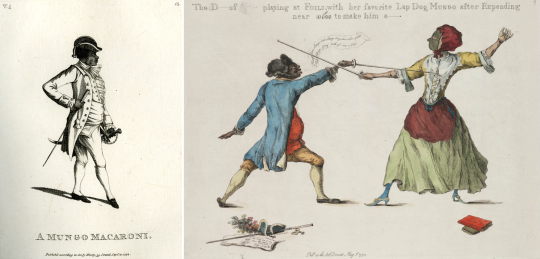
[Left: A Mungo Macaroni, print, c. 1772, by Matthew Darly, via The British Museum.
Right: The D------ of [...]-- playing at foils with her favorite lap dog Mungo after expending near £10000 to make him a----------*, print, c. 1773, by William Austin, via Yale Center for British Art.]
The expense of Stede’s wardrobe is a key part of the narrative. Stede has nice fancy luxurious things. Ed wants nice fancy luxurious things. Ed was born a poor brown boy and while he may be rich now he can never truly change his class. He could be as rich as Richard Cosway or Julius Soubise but to the gentry he will always be that poor brown boy.

Gender
As we have already seen in the tirade against men using umbrellas the macaroni was perceived as being of “the doubtful gender”. (The Morning Chronicle, 4 Oct, 1784)
The Natural History of a Macaroni writes that there “has within these few years past arrived from France and Italy a very strange animal, of the doubtful gender, in shape somewhat between a man and monkey,” that dresses “neither in the habit of a man or woman, but peculiar to itself”. The author states that “they are in no respect useful in this country”:
that the minister of the war department would give orders to have them enlisted for the service of America: we do not mean to put them on actual duty there. Alas! they are as harmless in the field, as they are in the chamber, but they may stand as faggots to cover the loss of real men.
(Walker’s Hibernian Magazine, July 1777, p458-9)
A “faggot” being “A man who is temporarily hired as a dummy soldier to make up the required number at a muster of troops, or on the roll of a company or regiment.” (see OED)

[The Masculine Gender & The Feminine Gender, etching with touches of watercolour, c. 1787, Attributed to Henry Kingsbury, via The Met.]
The macaroni wasn’t just considered effeminate because of the way they dressed but also because of their interests and the way walked and talked. Famous for playing fops and macaroni, the actor David Garrick did a lot to establish the character of the macaroni in the public mind. In his poem The Fribbleriad Garrick mocks the men who were offended by his performances asserting, perhaps accurately, that they were offended because it was them he mocked. He portrays a group of angry effeminate men meeting in order to seek revenge on him for his portrayal of them:
May we no more such misery know!
Since Garrick made OUR SEX a shew;
And gave us up to such rude laughter,
That few, ’twas said, could hold their water:
For He, that player, so mock’d our motions,
Our dress, amusements, fancies, notions,
So lisp’d our words, and minc’d our steps,
The macaroni had become more than simply an effeminate man, he had become a new sex. Something not quite man or woman. Something in-between. A new description of a macaroni asks the question:
Is it a man? ‘Tis hard to say - A woman then
- A moment pray -
So doubtful is the thing, that no man
Can say if ‘tis a man or woman:
Unknown as yet by sex or feature,
It moves - a mere amphibious creature.
(McNeil p169)
Sexuality
Much like today in the 18th century effeminacy was associated with homosexuality. Men who had sex with other men were known as mollies. A Classical Dictionary of the Vulgar Tongue (1785), defined a molly as “A Miss Molly; an effeminate fellow, a sodomite”. In the History of the London Clubs (1709), Ned Ward characterises mollies as follows:
There are a particular Gang of Wretches in Town, who call themselves Mollies, & are so far degenerated from all Masculine Deportment or Manly exercises that they rather fancy themselves Women, imitating all the little Vanities that Custom has reconcil’d to the Female sex, affecting to speak, walk, tattle, curtsy, cry, scold, & mimick all manner of Effeminacy.
“By the 1760′s,” explains Peter McNeil, “too much attention to fashion on the part of a man was read as evidence if a lack of interest in women”. (p152)
Macaroni were often portrayed as incapable or simply uninterested in sexual relations with women. This attitude is expressed by Mr. Bate in the following dialogue from The Vauxhall Affray; Or, the Macaronies Defeated:
Mr. Fitz-Gerall: I always though a fine woman was only made to be looked at.
Mr. Bate: Just sentiments of a macaroni. You judge of the fair sex as you do your own doubtful gender, which aims only to be looked at and admired.
Mr. Fitz-Gerall: I have as great a love for a fine woman as any man.
Mr. Bate: Psha! Lepus tute es et pulpamentum quæris?
Mr. Fitz-Gerall: What do you say, Parson?
Mr. Bate: I cry you mercy, Sir, I am talking Heathen Greek to you; in plain English I say, A macaroni you, and love a woman?
Mr. Fitz-Gerall: I love the ladies, for the ladies love me.
Mr Bate: Yes, as their panteen, their play-thing, their harmless bauble, to treat as you do them, merely to look at
While lack on interest in woman does not necessarily mean attraction to men, Matthew Darly takes the implication there in his 1771 set of macaroni caricatures which induces a print entitled Ganymede, a reference to Zeus’ male lover of the same name. Ganymede is believed to be a parody of Samuel Drybutter who had been arrested for attempted sodomy in January 1770. Darly also includes the character Ganymede in Ganymede & Jack-Catch. Jack-Catch is a reference to the infamous English executioner John Ketch. In the print Jack-Catch says, “Dammee Sammy you’r a sweat pretty creature & I long to have you at the end of my String.” Ganymede replies, “You don’t love me Jacky”. Jack-Catch is holding a noose with one hand and stroking Ganymede’s chin with the other. Jack-Catch is soberly dressed in typical 18th century menswear, while Ganymede’s dress is distinguished by his lace ruffles and styled wig. The print is not only suggesting that macaroni are sodomites but making a joke of the execution of them. The punishment for a sodomy at this time in England being death by hanging.

[Left: Ganymede, print, c. 1771, Matthew Darly, via The Met.
Right: Ganymede & Jack Catch, print, c. 1771, Matthew Darly, via The British Museum]
An anonymous letter to the Public Ledger (5 Aug, 1772) says blatantly what others had already implied. “The country is over-run with Catamites, with monsters of Captain Jones’s taste, or, to speak in a language witch all may understand, with MACCARONIES”. The writer warns macaroni who have “escaped detection” as sodomites and “therefore cannot fairly be charged” that they have not avoided suspicion:
Suspicion is got abroad-the carriage-the deportment-the dress-the effeminate squeak of the voice-the familiar loll upon each others shoulders-the gripe of the hand-the grinning in each others faces, to shew the whiteness of the teeth-in short, the manner altogether, and the figure so different from that of Manhood, these things conspire to create suspicion; Suspicion gives birth to watchful observation; and, from a strict observance of the Maccaroni Tribe, we very naturally conclude that to them we are indebted for the frequency of a crime which Modesty forbids me to name. Take warning, therefore, ye smirking group of Tiddy-dols: However secret you may be in your amours, yet in the end you cannot escape detection;
Bows on His Shoes
18th century shoes were typically buckled, laces and ribbons were simply unfashionable. As mentioned previously macaroni were distinguished by the size and decoration of the buckles. So are Stede’s bows simply ahistorical? Well there are references to 18th century men wearing laces and ribbons.
Towards the end of the 18th century laces started to come into fashion. Appeal from the Buckle Trade of London and Westminster, to the Royal Conductors of Fashion (1792) complained that despite how “tender and effeminate the appearance of Shoe Strings” the “custom of wearing them has prevailed.”
Perhaps the most intriguing reference is that of Commissioner Pierre Louis Foucault’s papers where he details the surveillance, investigation and entrapment of "pederasts” in Paris. It is important to note that the word “pederasty” was used synonymously with “sodomy” in the 18th century and did not denote age simply sex. An Universal Etymological English Dictionary (1726) defines “A pederast” as “a Buggerer” and “Pederasty” as “Buggery”.
Foucault and the men working with him identified particular clothing worn by men seeking sex with other men that he called the “pederastical uniform”. In Foucault’s papers men are described as being “attired in such a way as to be recognized by everyone as a pederast”, “clothed with all the distinctive marks of pederasty”, or simply “dressed like a pederast”. This “uniform” generally included “some combination of frock coat, large tie, round hat, small chignon, and bows on the shoes.” Jeffrey Merrick in his article on Foucault speculates that these men dressed this way to signal to each other. However when questioned by police they would understandably deny such a purpose, one man when questioned about his outfit responded that everyone “dresses as he sees fit”. (Jeffrey Merrick, Commissioner Foucault, Inspector Noël, and the “Pederasts” of Paris,1780-3)
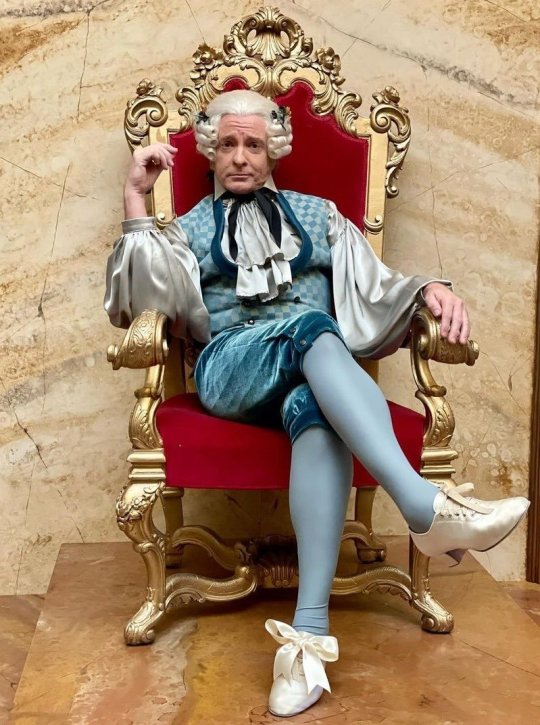
Conclusion
I’m not saying Stede is intended to be a macaroni. If that were the case they would have given him the iconic macaroni hairstyle. However the costuming team has clearly pulled from fashion trends that were associated with effeminacy and homosexuality. While OFMD is evidently wholly unconcerned with creating period accurate costumes the costumes are still clearly inspired by historical fashions. Perhaps the curtains really are just blue but maybe Stede wears bows on his shoes because he’s gay.
#I had way too much fun doing this#our flag means death#ofmd meta#stede bonnet#queer history#macaroni#historical fiction#fashion history
197 notes
·
View notes
Text
Listen.
If you've read my fics, you know that I love history. I love pageantry. I love symbolism. I love beautiful clothes, and art, and jewels. I love going behind the scenes and seeing into castles and manor houses. I love parades, and the hidden meaning behind coronations, and the fairytale unreality of the lives of the gentry.
I believe, however, that all of these things should be ARTIFACTS.
I believe there is literally no point in upholding a monarchy or commonwealth any more.
Allow commonwealth countries become republics. Allow Scotland, Northern Ireland, and Wales to return to being seperate nations if they vote to become so. Allow those republics to create their own network of mutual support, should they so choose to. There's no reason to not keep up Commonwealth ties and festivals even if there's no Commonwealth.
Repatriate artifacts, art and jewels to their nations of origin. Offer monetary compensation/support for cultures violated and impoverished by colonialism. Help establish democracies where needed, and butt the hell out where they're not. (And especially don't establish puppet democracies, ew.)
Let the British royal family become symbolic tourist attractions, let them fund their own charities, and throw their parties, and knight their artists, and uphold their royal orders of garters and baths, and maintain their personal properties--and make them do it with their own wealth and real estate investments. They're multi-billionaires. They can afford it. They'll be fine.
But remove them from the machine of governance. Detach them entirely from public spending, dependance, or influence.
And if they do participate in traditions of parliament (like the Opening, which is actually really cool and fascinating panto, which I quite like and hope they WOULD continue), man, do it without the silly hat. If the King wants to wear the silly hat, make him pay for the upkeep of the silly hat out of his own pocket. It's HIS silly hat, after all. It's not like we all get a turn with it, even though we do pay for it.
(Actually, the Crown Jewels are owned by the British Public so like... if they want to take them along when they go, make the royal family buy them. And then let them charge museums a fee to loan them for exhibition, just like privately owned paintings by famous Masters are loaned to art galleries.)
Let the royals continue to do all the things the royals do, if they want to do them. Just… make them pay for it themselves. Dissolve the Sovereign Grant, and use all that money to pay for things like restitution, repatriation, and hey maybe increasing public spending on health care and social infrastructure.
Turn the public-owned properties into, yeah, tourist attractions in part (gotta fund their upkeep somehow). But also put public offices in there. Maybe some social housing. Maybe hospitals, with well-paid front-line staff. Event spaces. Seniors care homes. Something.
If Hampton Court Palace can do it, so can Buckingham.
Balmoral and Sandringham are privately owned, there's lots of land and buildings for the family to occupy. They won't be homeless.
Keep the royal family, if the royal family wants to be kept. Include the royal family if the royal family wants to be included. Just make them pay for their own stuff with their own money. And do BETTER things with the savings.
Yes, I'm aware that this may be wishful thinking.
Yes, I'm aware that unscrupilous people may take advantage of monetary support given to commonwealth nations and keep it for themselves. (And I'm not unaware that it would happen in ALL the nations, yes, even Canada where I live. There are a LOT of currently-serving politicians who are vile, scummy, self-serving arseholes.) Yes, I'm aware that mutual support between nations of the commonwealth is all that is preventing famine or religious war in some places.
Yes, I'm aware none of this is as easy as I'm making it sound.
But I think it's time to stop celebrating and upholding centuries of brutal militaristic colonialism and the destruction and subversion of so many beautiful cultures for the sake of some tourist bucks. I especially think it's time for the public to stop PAYING for it.
I love history. I love symbolism. I love the stories of royalty and treachery and gallantry and seduction. I love the architecture of great houses, and the meaning behind golden spoons from over a thousand years ago, and the fascination of birthrights and bloodlines. I love paintings, and balls, and the gorgeous work of exceptionally talented artisans that go into making all the amazing silly hats.
I write historical romances for goshsakes.
And I also think it's time to stick it all where it belongs -- in a museum.
55 notes
·
View notes
Text
Stats 2: Electric Boogaloo
Our 256 works are comprised of.... 132 paintings, 36 drawings / digital artworks / comics, 26 installation pieces, 20 sculptures, 11 buildings, 11 public artworks, 10 photographs, 4 prints, 3 cave arts, 2 textile arts, and 1 thing I classified as a collage instead of anything else!
More stats below!
Most popular city: New York, with 13 pieces, followed by Paris with 8, and Chicago is third with 7! Washington DC has 6, Florence, Madrid, and London all have 5, Philadelphia has 4, Dublin, Edinburgh, Mexico City each have three, and all the following cities have two: Boston, Cairo, Calgary, Cordoba, Helsinki, Houston, Jerusalem, Los Angeles, Munich, Ottawa, Prague, Vienna, Warsaw
Most popular museum: somehow the Art Institute of Chicago has the most with 6 pieces! Followed by the Museum of Modern Art with 5 pieces! The Museo del Prado has 4, the Philadelphia Museum of Art has 3, and the Ateneum, Louvre, Metropolitan Museum of Art, Museo Dolores Olmedo, National Gallery of Canada, Solomon R. Guggenheim Museum, Tate Britain, Tretyakov Gallery, and the Uffizi Gallery each have 2! In addition, the single works are spread out amongst 16 city level galleries (ie the Phoenix Art Museum), 5 state/provincial (ie Queensland Art Gallery), 25 national (ie National Gallery Prague), 8 museums named after benefactors (ie the Hirshhorn Museum), 7 museums dedicated to a specific artist (ie the Van Gogh Museum) and numerous other institutions! Churches, palaces, increasingly specific museums, museums that are named after their location rather than their governmental level... and of course a whole lot of private collections and pieces we were unable to find the location of!
Countries! 50 pieces are in the US! 13 in France! 12 in Spain! 7 in England, 6 in Canada and Italy, 5 in Russia, 4 in Ireland, Mexico, and Australia, 3 each in Germany, Austria, and Scotland, and 2 each in China, the Netherlands, Israel, Finland, Wales, Poland, Japan, Egypt, and India, and 1 each in Portugal, Ecuador, Thailand, Singapore, Belgium, Argentina, Sweden, the Czech Republic, Norway, Bangladesh, Saudi Arabia, and the Vatican!
Demographics! I revoked John Singer Sargents American status for these because he was born in Europe, and spent most of his life travelling around Europe. I tried my best to track down the correct numbers but honestly some of these are likely to be slightly off. I went with easily publicly available information like Wikipedia and where that failed the author's website. I also tracked people's birth countries in addition to where they lived / worked for most of their lives. Anyway! We have 74 pieces by American artists! 27 French, 22 English, 14 Russian, 13 Spanish, 11 Canadian, 9 Italian, 8 Chinese, 8 German, 6 Irish, 6 Polish, 6 Mexican, 5 Greek (four of those are Ancient Greece), 5 Ukrainian, 5 Japanese, 4 Australian, 4 Belgian, 4 Indian, 3 Serbian, 3 Armenian, 3 Dutch, 3 Austria, 3 Latvian, 3 Swedish, 2 each from Finland, Scotland, Malaysia, Cuba, the Czech Republic, and Norway, and one each from Israel (specifically), Portugal, Ecuador, Thailand, Switzerland, Denmark, Iran, Colombia, Chile, Estonia, and Egypt (albeit Ancient Egypt)
Including the one Israeli artist, we have 7 Jewish artists represented, as well as 4 Black, 6 Indigenous (one is half Kichwa, one is Sami, one is Haida, one is Ojibwe, and two are Australian Aboriginals. One of those is Kokatha and Nukunu, and the other one was a group project with eight artists who did the majority of the work, and 6 of those are from Erub Island but the articles did not specify further except that at least one of the eight is non-Indigenous), 1 Chicana, and 1 Asian-American (which I am specifying because I felt very stupid adding tallies to an Asian column when I already said there are 8 Chinese artists and 5 Japanese and 2 Malaysians and....). We also do have 16 artists that publicly identify as queer in some fashion! I have listed 9 works by gay men, 2 works by lesbians, and 5 that have chosen to use "queer" instead of other labels.
And on that note.... we have 155 works by men, 51 by women, and 2 by nonbinary artists!
Most represented artists! Frida Kahlo and René Magritte tied with four works each! Félix González-Torres, Francisco Goya, John Singer Sargent each have three! And the artists that have 2 artworks each are... Claude Monet, Dragan Bibin, Edmund Blair Leighton, Francisco de Zurbarán, Gustav Klimt, Holly Warburton, Hugo Simberg, Ilya Repin, Ivan Aivazovsky, Jacques-Louis David, Jenny Holzer, Louis Wain, Pablo Picasso, Sun Yuan & Peng Yu, Victo Ngai, Vincent van Gogh, Pierre-Auguste Renoir, and Leonardo da Vinci (although the second is debated attribution)! That means that 205 of the works are not by any of the above! Some have unknown artists (we've got THREE CAVE ARTS) but most are just... really varied!
And lastly, years painted (as sorted by year finished and not year started). Who else loves when something is listed as "13th century"?? Not me, that's who. This is going to be a lot of numbers, and there's no real way to make it more readable. so..... feel free to skip!
The oldest two submissions are from circa 40,000 years before present, and 30 to 32 thousand years before present! Six more artworks came to exist before 0 (CE or AD depending on who you're talking to), and 7 before 1000! 2 from the 1200s, 6 from the 1400s, 8 from the 1500s, 3 from the 1600s, and 5 from the 1700s! Several of those already listed were started in a previous ....age category (for instance, one has no specified date other than 7300 BC to 700 AD) but once we hit 1600, everything is usually finished in a relatively short timespan. 6 are from 1800-1850, 9 from 1850-1880, and the 1880s are extremely busy. 1 from 1881, 3 from 1882, 1 from 1883-1885, 5 from 1886, and two each from the next four years (1887-1890)! 6 from 1891-1895, and 5 from 1896-1900!
We've got 3 from 1901 or 1902, 4 from 1903, two each from 1906 and 1907, and one each from 1908 and 1909! 3 from 1910-1915, 3 from 1917, 2 from 1918 and one from 1919! 6 are from the Roaring Twenties, three of them specifically from 1928! 4 from 1931-1935, and only 3 from the latter half of the 30s! There's 3 from WWII, and 4 from 1946-1949, 5 from 1951-1954 but only 3 from '55-'59. 5 from the sixties, 7 spread out through the 70s, and 10 from the 80s, two each from 81, 82 and 84. The 90s have a lot of duplicate and triplicate years, totaling 20 overall! 11 are from 90-95, the other 9 are 96-99. 7 from 2001-2005, and 8 from 2006-2009. 9 from 2010-2014, 3 from 2015, 6 from 2016, 5 from 2017, 1 from 2018, 3 from 2019, 5 from 2020, 1 from 2021, 4 from 2022, 11 from 2023, and 3 ongoing projects! Whew! If anyone wants it listed By Year instead of in groups like this, that'll be most readable in like... list form and that's way too long for a stats post.
Congrats on making it to the end! If you got this far, uh, let me know if you want to see the spreadsheet after the tournament, I guess. I'm very proud of it.
50 notes
·
View notes
Photo

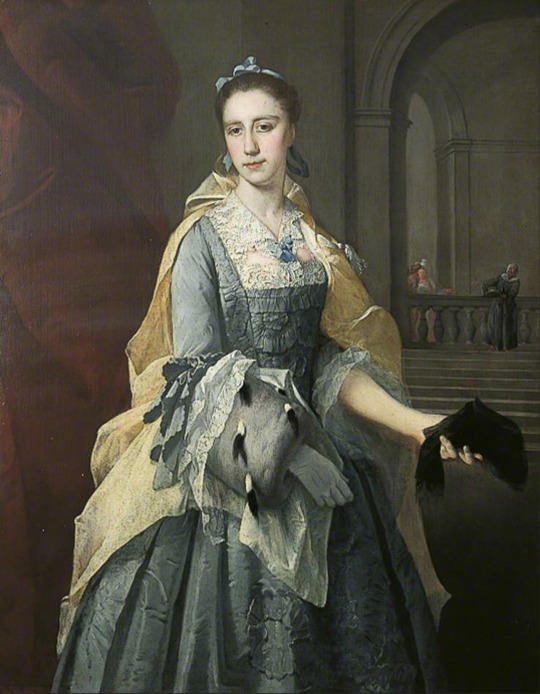



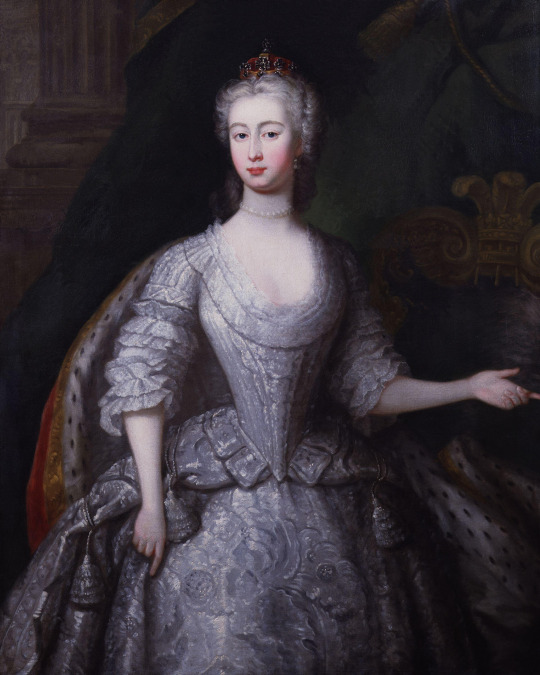
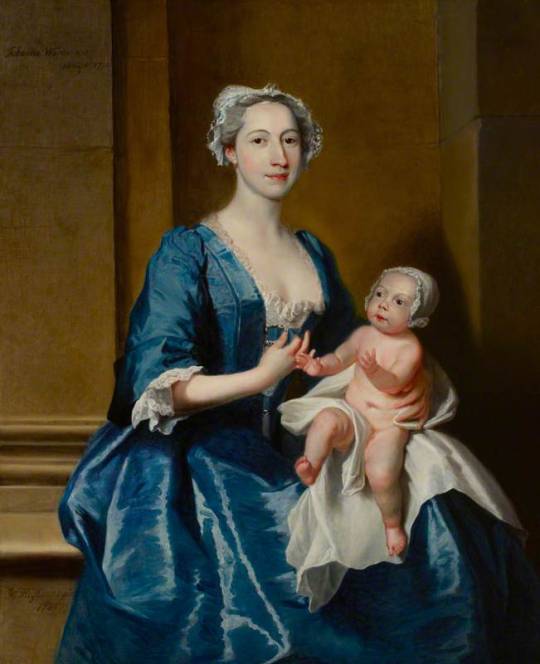
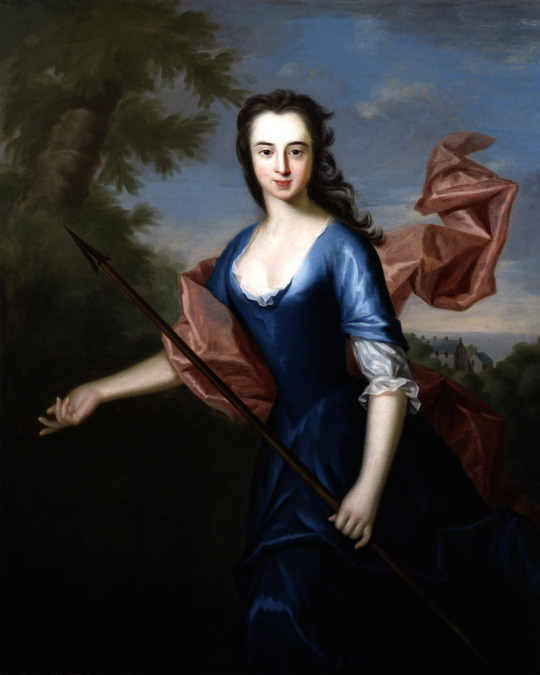
Further into the thirties (from top to bottom) -
The sleeves are usually elbow length and close, but not tightly squeezing, the arm and cuffed, An under-sleeve with a flared cuff emerges from the sleeve.1735 A Music Party by Marcellus Laroon (Birmingham Museums & Art Gallery - Birmingham, West Midlands, UK). From their Web site 1638X2246. No panniers here.
1735 Catherine Havers attributed to Barthélemy Du Pan (Temple Newsam House - Leeds, West Yorkshire, UK). From artuk.org 1414X1818. The dress could have been worn, minus the cuffs, until the 1770s.
1735 Catherine Hyde, Duchess of Queensberry, as a Dairy Maid, Marble Hill by Charles Jervas (Marble Hill House - Twickenham, London, UK). From artsandculture.google.com/entity/catherine-douglas-duchess-of-queensberry/m0gfdypy 1722X2138.
1735 Henrietta, née Godolphin, wife of Thomas Pelham-Holles, Duke of New Castle Upon Tyne and first Duke of Newcastle Under Tyne and Prime Minister by Charles Jervas (auctioned by Sotheby's) 920X1163.
1736 Anne, Princess Royal and Princess of Orange by Bernard Accama (location ?). From the lost gallery's photostream on flickr 1047X1539.
1736 Augusta of Saxe-Gotha-Altenburg, Princess of Wales by Charles Philips (National Portrait Gallery - London, UK). From www.liveinternet.ru/users/marylai/post292168318 2400X2998.
1736 Johanna, Mrs Robert Warner of Bedhampton, and Her Daughter, Kitty (d.1772), Later Mrs Jervoise Clarke Jervoise by Joseph Highmore (Mottisfont Abbey - Mottisfont, near Romsey, Hampshire, UK). From bbc.co (now artuk.org) 651X800.
1736 Katherine Hall of Dunglass by Allan Ramsay (private collection). From the Philip Mould Historical Portraits Image Library; fixed spots w Pshop 2418X3023.
#1730s fashion#Georgian fashion#Louis XV fashion#Rococo fashion#Marcellus Laroon#train#shoes#Catherine Havers#Barthélemy Du Pan#lace engageantes#fur muff#Catherine Hyde#Charles Jervas#U neckline#Henrietta Godolphin#V neckline#modesty piece#Princess Royal Anne#Bernard Accama#robiings#Princess of Wales Augusta#Charles Philips#court mantua#Johanna Warner#Joseph Highmore#cap#square neckline#Katherine Hall of Dunglass#Allan Ramsay#long hair
26 notes
·
View notes
Text
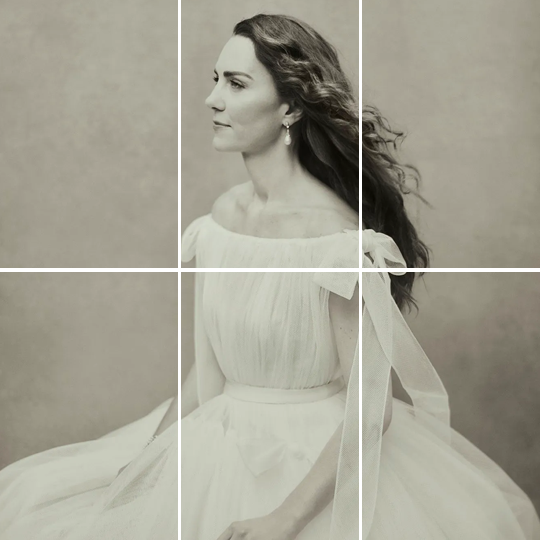

The Princess of Wales' Year in Review: January
January 9th - Catherine turned 40. In honour of her birthday, Kensington Palace released three new portraits, taken by Paolo Roversi, which will enter the permanent collection of the National Portrait Gallery
January 18th - The Duchess of Cambridge held an Early Years Meeting in her role as Patron of the Royal Foundation
January 19th - The Duke and Duchess of Cambridge made their first public appearance of the year, as they visited the Foundling Museum
January 20th - The Duke and Duchess of Cambridge visited Clitheroe Community Hospital, in Lancashire, in their roles as Patrons of NHS Charities Together. William and Catherine then visited Church on the Street Ministries
January 25th - The Duchess of Cambridge, in her role as Patron of the Royal Foundation of The Duke and Duchess of Cambridge, held a Centre for Early Childhood Meeting. She then held a telephone meeting with Miss Jennifer Urquhart (Chairman of Johnstons of Elgin), before holding a telephone meeting with Dr Edward Morris (President) and Kate Lancaster (Chief Executive), in her role as Patron of the Royal College of Obstetricians and Gynaecologists
January 26th - The Duchess of Cambridge, Patron of the Royal Foundation of The Duke and Duchess of Cambridge, visited Shout volunteers to mark the text support service’s One Million Conversations Milestone
January 28th - The Duke and Duchess of Cambridge, joint Patrons of the Royal Foundation of The Duke and Duchess of Cambridge, received Lord Hague and Simon Patterson
#mine#royaltyedit#kate#yearreview#official portraits#ey meeting 22 1#foundling museum 22#clitheroe community hospital#church on the street#centre for early childhood meeting 22 1#jennyurquhart22#morrislancaster22#shout22#haguepatterson22 1#p: rf#p: og
71 notes
·
View notes
Text
Wales Day 5
June 17th
Today was quite a busy day! We started our day touring the beautiful campus of the University of Aberystwyth. I enjoyed admiring all of the beautiful greenery and foliage whilst learning about the history of the university and how much it has developed over the years. One of the highlights of the day for me was going to see the exhibition currently on display at the arts center on campus. I am excited that we were able to see a Picasso in Wales!
After spending some time in the art gallery, we took the bus to The Old College Aberystwyth University where we got to learn about the history of the college.
After the lecture, we enjoyed some time exploring the area of downtown Aberystwyth for lunch. Then we headed back to campus and toured the archives of the National Museum of Wales! It was extremely fascinating to learn about all of the intricate details that go into preserving such historic artifacts.
We ended the evening with a nice pub dinner and a trip to the beach to catch the sunset. I thoroughly enjoyed learning all about Aberystwyth today!
@danielcronrath










6 notes
·
View notes
Text
STATE VISIT BY THE EMPEROR AND EMPRESS OF JAPAN
Tuesday 25th - Thursday 27th June 2024
Their Majesties The Emperor and Empress of Japan will pay a State Visit to the United Kingdom as guests of His Majesty The King from Tuesday 25th to Thursday 27th June 2024.
SATURDAY 22nd JUNE
The Emperor and Empress of Japan will arrive privately in the United Kingdom on the afternoon of Saturday 22nd June at Stansted Airport.
Their Majesties will be greeted by His Excellency Mr Hajime Hayashi, Ambassador of Japan. The Viscount Brookeborough KG, Lord-in-Waiting, will greet Their Majesties on behalf of The King.
SUNDAY 23rd JUNE AND MONDAY 24th JUNE
Before the State Visit formally commences, the Emperor will conduct a private programme of engagements, including a visit to Japan House and the Thames Barrier.
TUESDAY 25th JUNE
His Royal Highness The Prince of Wales will greet the Emperor and Empress of Japan, at their hotel, on behalf of The King on Tuesday morning.
His Royal Highness will travel with the Emperor and Empress to Horse Guards Parade, where Their Majesties will receive a Ceremonial Welcome.
The King and Queen will formally welcome the Emperor and Empress at the Royal Pavilion on Horse Guards Parade. Presentations will be made, the Guard of Honour will give a Royal Salute and the Japanese National Anthem will be played.
The Emperor, accompanied by The King, will then inspect the Guard of Honour, formed of the 1st Battalion Welsh Guards with the Band of the Welsh Guards. Afterwards, the Emperor and Empress will join The King and Queen, and The Prince of Wales, in a carriage procession along The Mall to Buckingham Palace, where they will be met by a second Guard of Honour formed of the 1st Battalion Welsh Guards.
Following a lunch at Buckingham Palace, given by The King, His Majesty will invite the Emperor and Empress to view a special exhibition in the Picture Gallery of items from the Royal Collection relating to Japan.
In the afternoon, the Emperor and Empress will visit Westminster Abbey, where the Emperor will lay a wreath at the Grave of the Unknown Warrior. Their Majesties will take a tour of the Abbey, accompanied by the Dean of Westminster.
In the evening, The King, accompanied by The Queen and Members of the Royal Family, will give a State Banquet at Buckingham Palace for The Emperor and Empress of Japan. Speeches will be made by The King and the Emperor at the beginning of the banquet.
WEDNESDAY 26th JUNE
The Emperor will visit The Francis Crick Institute, the UK's flagship biomedical research centre.
The Institute supports an innovative UK-Japan research partnership which covers a range of public health issues, including cancer, vaccines, and the role of genetics in infectious diseases.
That evening, The Emperor of Japan, joined by Their Royal Highnesses The Duke and Duchess of Edinburgh, will attend a Banquet at the Guildhall given by the Lord Mayor and City of London Corporation. The Lord Mayor and The Emperor will both make speeches at the end of the banquet.
THURSDAY 27th JUNE
The Emperor and Empress of Japan will formally bid farewell to The King and Queen at Buckingham Palace on the morning of the final day of the official State Visit programme.
The Emperor and Empress will travel to Young V&A, part of the V&A family of museums dedicated to the power of creativity around the world, where the museum's Japan: Myths to Manga exhibition is currently on display.
The Emperor will privately visit St. George's Chapel, Windsor Castle, to lay a wreath on the tomb of Queen Elizabeth Il, in the King George VI Chapel. The Garter Banners of the current members of the Order of the Garter, including the banner belonging to His Majesty's father, Emperor Emeritus Akihito, are displayed in the Quire of St. George's Chapel.
Later that afternoon, His Majesty the Emperor will tour the historic Temperate House at the Royal Botanic Gardens, Kew. The Millennium Seed Bank, coordinated by Kew is the world's largest collection of over 2.4 billion wild plant seeds spanning 97 countries, preserving Japanese and international biodiversity. Bronze Bonsai sculptures by artist Marc Quinn are currently displayed in the Temperate House, surrounded by a display of Bonsai trees from Kew's collection.
FRIDAY 28th JUNE
On their final day in the UK, The Emperor and Empress of Japan will visit Oxford for a private programme of engagements including a visit to the colleges where Their Majesties studied.
At the conclusion of the visit, The Lord Chamberlain will bid farewell to the Emperor and Empress on behalf of The King, before they depart from RAF Brize Norton.
#eeeek so exciting!!!#this is like a birthday present to me lol#it starts right on my birthday#emperor naruhito#empress masako#king charles iii#queen camilla#william prince of wales#prince edward duke of edinburgh#sophie duchess of edinburgh#japanese state visit#news
10 notes
·
View notes
Photo


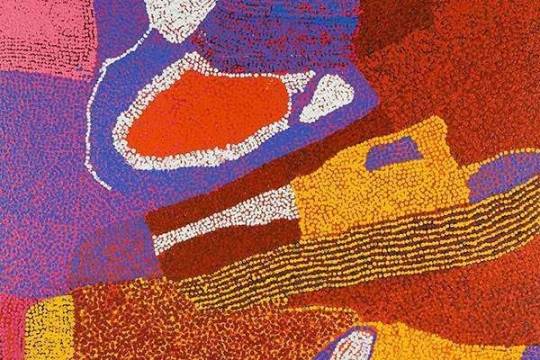

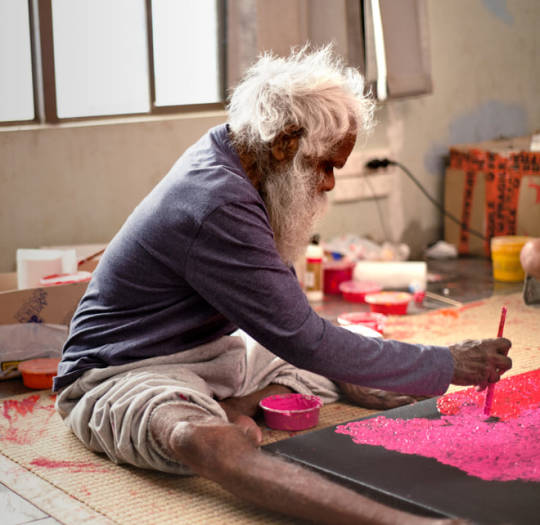
Yannima Tommy Watson (ca. 1935-2017) was born at Anamarapiti, approximately 40 kilometres west of the small community of Irrunytju (also known as Wingellina) Irrunytju is situated in Western Australia near the tri-state border of Western Australia, South Australia and the Northern Territory. Watson is a Pitjantjatjara man, and his skin group is Karimara. He spent his early childhood and teenage years living with his family, travelling from water hole to water hole, hunting and gathering and learning from his father the practical skills on how to survive on their lands in the arid regions of the Gibson Desert. While growing up he learned to understand the significance of social organization and the spiritual and tribal law teachings of his ancestors. Watson also inherited the knowledge on how to find water and food within their region. However, the fate of Watson and his family and many of the other western desert nomads was sealed with the introduction of assimilation policies. This combined with the severe drought throughout the 1950’s resulted in many of the Pitjantjatjara, Ngaanyatjarra and Pintupi Aborigines moving from their home lands to the administrative centres in Warburton, Ernabella and Papunya. The unfamiliar world of the Government settlements was no place for these free nomadic people who were use to a life of unlimited travel, they became disoriented and more than half of the population of these new communities died. Most never adjusted and eventually in the 1970’s and early 1980’s returned to their traditional homelands.
In 2001 Watson was one of the founding artists of the Irrunytju art centre. His work is rich in the knowledge of the topographical landforms of his country and the Tjukurrpa law that underlies it. He paints the stories of his mothers and grandfather’s country recording the sacred dreamtime stories intuitively using large vibrant colourful dots of pinks, burgundy, orange and reds to symbolically represent the dreamtime journeys of the ancient spirits and the significant episodes in the history of his tribe.
“My grandfather’s country, grandmother’s country. When they were alive, they would take me around the country, when I was a kid. That’s why we look after country, go out whenever we can. See if the rock holes are good”
His most important dreamtime stories are the Great Flood Dreaming, a story of the melting ice that flooded the lands north of the Great Australian Bight. Another story tells of the Pangkalangku, tall man eaters from the north east and his other stories tell of the tribal conflicts between the Pitjantjatjarra and the Yankunyatjarra.
As a young man Watson became a stockman at Mount Ebenezer, and then travelled to Yuendumu where he gained a reputation as an exceptional horseman. He is now a tribal elder and law man and frequently travels widely across the Pitjantjatjara lands to fulfil his traditional obligations. Today he divides his time between the remote community of Warakurna on the edge of the Great Victorian Desert and Alice Springs where he has a house and painting studio. He is widely recognised nationally and internationally and his work is represented in the National Gallery of Australia, Canberra, National Gallery of Victoria, Melbourne, Art Gallery of New South Wales, Sydney, Western Australian Art Gallery, Perth, South Australian Art Gallery, Adelaide and in many important private collections .He was commissioned in 2005 to produce artwork to be permanently installed in the Musee du Quai Branly in Paris, France, which opened in 2006. The painting Wipu rockhole (2006) was enlarged and reproduced on stainless steel tiles which adorn a ceiling within the museum.
Ken McGregorhttps://www.metrogallery.com.au/artist-tommy-watson
37 notes
·
View notes